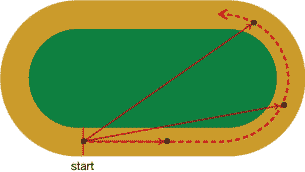Module 1—Motion
 Reflect and Connect
Reflect and Connect
Online mapping services can be used to produce detailed directions for getting from one location to another.
 Try This
Try This
TR 13. Working in a group or by yourself, generate and print a map showing how to go from your house to another location, such as your school or work. The other location must be at least one kilometre away and require more than two changes in direction.
TR 14. On the map, draw the vector that shows the displacement from your house to the other location (straight line).
TR 15. How can the magnitude and direction of this vector be determined using your map? Define the magnitude and direction using the Cartesian and navigational methods.
TR 16. Post your map to the discussion area, and view other maps. How did the straight-line displacement value (the “as the crow flies” version) compare to the distance value (path length) for your route?
 Module 1: Lesson 1 Assignment
Module 1: Lesson 1 Assignment
Remember to submit the answer to Discuss to your teacher as part of your Module 1: Lesson 1 Assignment.
 Discuss
Discuss
Average velocity is determined by dividing displacement by time. Position in a chuckwagon race can be illustrated with a vector arrow drawn from the starting point to the current location. The following diagram illustrates several position vectors drawn at different times in the race.

Use this diagram to explain why the displacement becomes zero just as the chuckwagon crosses the finish line and why the chuckwagon has an average velocity of zero when it reaches the finish line. Submit a copy of your response to your instructor, and store a copy in your course folder.
 Reflect on the Big Picture
Reflect on the Big Picture
In this lesson a number of important concepts have been discussed and worked with. You saw how the mathematics of vectors and scalars can help you describe where objects are and how they move. You worked with different ways of describing the direction of an object’s motion. You discovered the non-intuitive idea that average velocity can be zero even if you are travelling very quickly. In working with these ideas, you have started to build a solid base for the rest of this module.
Reflection is an activity that tries to culminate your learning experience by pondering who, what, when, where, and why about the activities you have completed. For this lesson, complete at least one of the following three activities and the KWL chart to help you reflect on your learning.
-
Create a poem that connects the concepts and terms you learned with the descriptive language used in poetry.
-
Create a drawing or painting that expresses the concepts of direction, motion, vector, and scalar. Add a small description to explain to others what the artwork is describing.
-
Build a summary of the concepts and terms. Ensure that it describes in your words how the items relate to description of motion.
Store your completed reflection in your Physics 20 course folder.
 Module 1: Lesson 1 Assignment
Module 1: Lesson 1 Assignment
Retrieve the Module 1: Lesson 1 Assignment you have been working on throughout this lesson. Ensure that you have completed all of the questions on the assignment. Save this completed copy to your Physics 20 course folder and submit a copy to your teacher.
KWL Chart
For your Module 1 Project, you will complete a KWL chart like the following with your thoughts about the concepts from this lesson. Store your KWL chart in the Physics 20 course folder. You will be expected to add to it in each lesson and submit the total chart to your teacher for grading once you have completed Module 1.
| K What I Knew |
W What I Want to know |
L What I Learned |
|---|---|---|